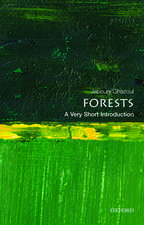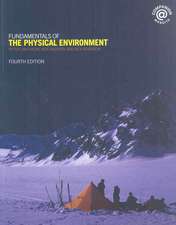A Future for Amazonia: Randy Borman and Cofán Environmental Politics
Autor Michael L. Cepeken Limba Engleză Paperback – noi 2012
Drawing on three years of ethnographic research, A Future for Amazonia begins by tracing the contours of Cofán society and Borman’s place within it. Borman, a blue-eyed, white-skinned child of North American missionary-linguists, was raised in a Cofán community and gradually came to share the identity of his adoptive nation. He became a global media phenomenon and forged creative partnerships between Cofán communities, conservationist organizations, Western scientists, and the Ecuadorian state. The result was a collective mobilization that transformed the Cofán nation in unprecedented ways, providing them with political power, scientific expertise, and a new role as ambitious caretakers of more than one million acres of forest. Challenging simplistic notions of identity, indigeneity, and inevitable ecological destruction, A Future for Amazonia charts an inspiring course for environmental politics in the twenty-first century.
Preț: 201.03 lei
Nou
Puncte Express: 302
Preț estimativ în valută:
38.47€ • 41.77$ • 32.32£
38.47€ • 41.77$ • 32.32£
Carte tipărită la comandă
Livrare economică 22 aprilie-06 mai
Preluare comenzi: 021 569.72.76
Specificații
ISBN-13: 9780292739505
ISBN-10: 0292739508
Pagini: 272
Ilustrații: 16 b&w photographs, 1 map
Dimensiuni: 152 x 229 x 18 mm
Greutate: 0.4 kg
Ediția:New.
Editura: University of Texas Press
Colecția University of Texas Press
ISBN-10: 0292739508
Pagini: 272
Ilustrații: 16 b&w photographs, 1 map
Dimensiuni: 152 x 229 x 18 mm
Greutate: 0.4 kg
Ediția:New.
Editura: University of Texas Press
Colecția University of Texas Press
Notă biografică
Michael Cepek is Assistant Professor of Anthropology at the University of Texas at San Antonio and a fellow in the Division of Environment, Culture, and Conservation at the Field Museum of Natural History. He began working with the Cofán people of Amazonian Ecuador in 1994 and continues to collaborate with them on academic and activist projects.
Cuprins
- Preface
- Acknowledgments
- Introduction: Cofán Possibilities
- Part I: An Individual and a People
- 1. Agency: The Emergence of an Intercultural Leader
- 2. Identity: Collectivity and Difference
- 3. Value: The Dilemma of Being Cofán
- Part II: An Experiment in Indigenous and Environmental Politics
- 4. The NGO: Institutionalizing Activism
- 5. The Forest: Collaborating with Science and Conservation
- 6. The School in the City: Producing the Cofán of the Future
- Conclusion: A Possible Forest
- Notes
- Bibliography
- Index
Recenzii
It is a well-crafted and nicely combined account of an ethnographic study with the personal story of Randy Borman…it is a must read for all those who want to understand the ecological sustainability efforts of indigenous people around the world in general, and the success story of the Cofán in Amazonia in particular.
We must thank Michael Cepek for an ethnography that not only sheds light on indigenous cultural resistance, but also allows us to imagine such questions.
What’s the fate of the Amazon’s ecology and indigenous people? Is cultural and biological destruction inevitable? This may be the predominant message we hear emanating from the global discourse, but, as we read in Michael Cepek’s lively and richly textured account of the Cofán people of eastern Ecuador, we may have reason to be more optimistic.
It is exciting and always refreshing to read an ethnography that, as Cepek puts it, uses empirical investigation of an existing liberatory project to help us conceptualize alternative futures of hope and possibility.
A Future for Amazonia is ideal for those in search of a rich, readable, ethnography that provides a remarkably rich account of an Amazonian indigenous people and how they have developed the political capacity to take on multinational oil, negotiate the Ecuadorian state, and secure a future that is at least partially hopeful. In short, this book makes an argument for why ethnography remains important for understanding much of what defines Latin America, from natural resource extraction and imperialism to indigenous movements, the ‘NGOization’ of political life, and the broader struggle for cultural and economic survival.
This book will be of interest to environmental anthropologists for its depiction of divergent cultural models of environmental conservation and ecological cosmovisions, and to scholars in Latin American studies for its analysis of indigenous social movements and their complex relationships with states and transnational NGO networks. It also makes important contributions to the emerging field of NGO studies by examining how the adoption of the NGO form entails the transformation of community identities and practices. Nonetheless, its greatest value lies in the way it challenges anthropologists to examine the cultural tools used by people to refashion their ways of living in order to secure some measure of control over their future in a complex and often unpredictable global context.
Cepek has done a marvelous job in documenting and explaining the nuances and narratives of the Cofán story. . . . The book, which is easy to read and very well written, is highly recommended, especially for anyone working in International Development, Development Education, Government, Conservation, or Anthropology. The larger value here is that Cepek provides a pragmatic vision, gained through his sustained relationship with Borman and the Cofán, which might help the world with its problem of maintaining biodiversity. It is a real life story, implemented and worked on by real people, not just a utopian vision. The accomplishments of the 'Cofán experiment' deserve to be carefully studied and debated
Descriere
A remarkable story of empowerment, tracing the efforts of Randy Borman, the “gringo chief” who stemmed the tide of dispossession and rainforest destruction beginning in the 1990s and helped the Cofán of Amazonian Ecuador flourish as the result of unique c











